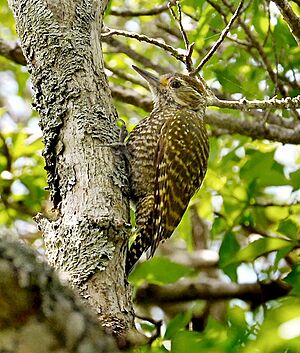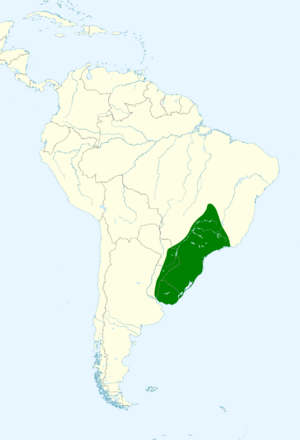White-spotted woodpecker facts for kids
Quick facts for kids White-spotted woodpecker |
|
|---|---|
 |
|
| A male white-spotted woodpecker at Rocha, Uruguay | |
| Conservation status | |
| Scientific classification | |
| Genus: |
Veniliornis
|
| Species: |
spilogaster
|
 |
|
| Synonyms | |
|
Dryobates spilogaster |
|
The white-spotted woodpecker (Veniliornis spilogaster) is a cool bird that belongs to the woodpecker family. It lives in parts of South America, including Argentina, Brazil, Paraguay, and Uruguay. These woodpeckers are known for their unique markings and how they find their food.
Contents
About This Woodpecker
Scientists like to group animals together based on how they are related. Most bird experts place the white-spotted woodpecker in a group called Veniliornis. However, some groups, like the American Ornithological Society, decided in 2018 to move all birds from Veniliornis into a different group called Dryobates. Even with these different ideas, everyone agrees that the white-spotted woodpecker is a single, unique species.
What It Looks Like
The white-spotted woodpecker is about 16 to 19.5 centimeters (6 to 7.7 inches) long. It weighs between 35 and 45 grams (1.2 to 1.6 ounces), which is about as much as a few AA batteries.
Males and females look very similar, but their heads are a bit different.
- Males have a yellowish-green forehead. Their crown (the top of their head) is dark brownish with tiny red streaks. The back of their neck is olive-green.
- Females have an olive-brown crown with small white spots.
Both male and female adults have a mostly brownish face. They have a thin white line above their eye (called a supercilium) and a thin white "moustache" line. Their faces also have white speckles.
Their upper body is mostly olive-green with yellowish or white edges on their feathers, which look like bars. Their flight feathers (the long feathers on their wings) are dark brown with whitish bars. Their tail is dark brown with thin off-white bars.
The underside of their body is dark olive. Their throat has strong yellowish-white streaks. Their chest has yellowish-white bars or spots, and their belly and under-tail feathers have clear yellowish-white bars.
Their eyes are a deep chestnut brown. Their beak is blackish-gray with a lighter color near the base. Their legs are olive or olive-gray. Male woodpeckers usually have a longer beak than females. Young woodpeckers look a lot like adults, but their markings are not as clear or regular.
Where It Lives
The white-spotted woodpecker can be found in several South American countries. It lives in Goiás and Minas Gerais in Brazil. From there, its home stretches south through southeastern Paraguay and most of Uruguay, reaching into northeastern Argentina, as far as Entre Ríos Province.
This woodpecker likes to live in different kinds of wooded areas. You can find it in:
- Humid lowland forests
- Forests along rivers
- Small, separate patches of forest
- Open woodlands
- Parks with some trees
How It Behaves
Movement
The white-spotted woodpecker does not migrate. It stays in the same area all year long.
Feeding
This woodpecker looks for food on many surfaces, including tree trunks, young trees, and even fence posts. It uses its strong beak to peck and hammer into wood. This helps it find and pull out beetle larvae and other insects. It also enjoys eating fruit and berries.
Life Cycle
White-spotted woodpeckers seem to lay their eggs between July and December. They dig out their nests inside tree cavities, usually just a few meters (several feet) above the ground. Scientists do not yet know how many eggs they lay, how long the eggs take to hatch, or how long it takes for the young birds to leave the nest. We also don't know many details about how the parents care for their babies.
Sounds It Makes
The white-spotted woodpecker has many different calls. Some of its sounds include:
- "cheékit ch che che che che che"
- "cheékit"
- "ti-rra-rra"
- "reh-reh-reh-reh"
When it is alarmed, it makes single "pic" notes. It also makes a "tapping signal" by hitting wood in groups of 2 to 4 taps, with pauses and single taps in between.
Its Status
The IUCN (International Union for Conservation of Nature) has looked at the white-spotted woodpecker and decided it is a species of "Least Concern." This means it is not currently in danger of disappearing. It lives across a very large area, and even though we don't know the exact number of these birds, scientists believe their population is stable. No immediate threats have been found for this species. It is considered common, and sometimes even very common, in many places. It also lives in several national parks. This woodpecker is quite adaptable and can live in many different kinds of wooded homes.


